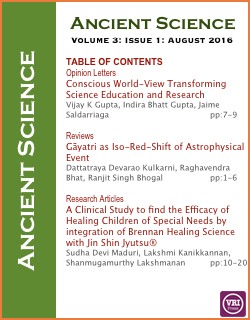

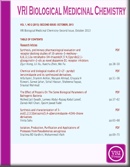













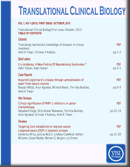

About Ancient Science
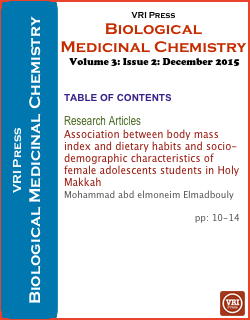 VRI-Biological Medicinal Chemistry (VRI-BMC) is an international scientific eJournal that publishes all areas of organic, synthetic and medicinal chemistry. It broadly accepts all the areas of chemistry, i.e. isolation, activity of chemicals, synthesis.
VRI-Biological Medicinal Chemistry (VRI-BMC) is an international scientific eJournal that publishes all areas of organic, synthetic and medicinal chemistry. It broadly accepts all the areas of chemistry, i.e. isolation, activity of chemicals, synthesis.
VRI-Biological Medicinal Chemistry publishes regular research papers, Letters to editor, Short Communications, Mini Reviews and Reviews that deals with all the aspects medicinal chemistry. VRI- Biological Medicinal Chemistry is encouraging scientists to publish experimental data in as elaborated as possible.
VRI-Biological Medicinal Chemistry will be published quarterly (4 issues per year). VRI- Biological Medicinal Chemistry is the rapid peer reviewed publication system, which will allow faster reviewing and notify editorial decision rapidly.
Â
Latest Issue Online
Volume 7, Issue 1 is now available.
A Special Invitation for Sponsorship
VRI-Biological Medicinal Chemistry seeks organizations interested in supporting unbiased research and educational practices. Learn more about opportunities to align your organization with this important initiative.
Sponsors
Sponsors of VRI-Biological Medicinal Chemistry will help advance topics and debates that address the most critical issue associated with continuing education in the healthcare field. A relationship with VRI-Biological Medicinal Chemistry positions sponsoring organizations as champions of unbiased research and educational practice among this discerning audience. Please contact admin, with any inquiries regarding sponsorship opportunities at vri@vripress.com |
Â
About Ancient Science
Ancient Science (AS) is an open access, peer-reviewed international journal that will consider original scientific research articles, opinion letters, short communications, mini reviews and reviews on ancient science from all around the world (e.g., Indian, Chinese, Egyptian, South American, etc.). This includes, but is not limited to, research that was part of Nalanda and Taxila, the earliest known universities in the world. Research may include ancient evolution theory, ancient mathematics and physics, astronomy and astrophysics, alchemy and metallurgy, biomedical sciences, natural sciences, social and economic fields, architecture, traditional medicine therapies, consciousness, scientific anomalies, alternative energy (Prana and Chakra energy, Yoga, Kundalini and Transcendental meditation etc.), alternative scientific hypotheses (paradigm shifts), and many other subjects that would be of special interest and value from the various ancient civilizations. In addition to publishing research, Ancient Science also seeks to promote a better understanding of the ancient cultures and the wonderful contributions they have made to modern science, medicine, and technology. Manuscripts must be original and of interest to an international audience. The main goal of Ancient Science is to promote the approximately 5000 year old, ancient Indian technology and culture. However, we welcome relevant peer-reviewed fundamental research information, based on scientific evidence, from around the world.
Latest Issue Online
Volume 6, Issue 1 is now available.
Â
Â
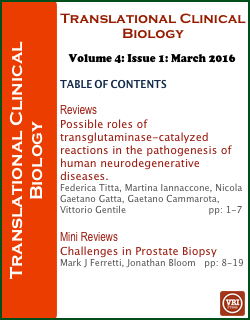 Translational Clinical Biology (TCB) is an international scientific, peer-reviewed eJournal that publishes only translational research, moving mechanistic knowledge of diseases obtained through basic science to its application in clinics and community. Â The goal is to bridge preclinical investigational work in the area of biomedical research with health outcome research. This will be achieved by promoting integration of genomic, proteomics and whole systems biology with population-based studies. TCB will provide a peer-reviewed platform for investigators in diverse disciplines who aim to translate benchside discoveries translate into clinic. Through TCB, we aim to foster improved patient prognosis and cure by encouraging healthy exchange of ideas in all the disciplines of biomedical research among basic scientists and healthcare providers.Â
Translational Clinical Biology (TCB) is an international scientific, peer-reviewed eJournal that publishes only translational research, moving mechanistic knowledge of diseases obtained through basic science to its application in clinics and community. Â The goal is to bridge preclinical investigational work in the area of biomedical research with health outcome research. This will be achieved by promoting integration of genomic, proteomics and whole systems biology with population-based studies. TCB will provide a peer-reviewed platform for investigators in diverse disciplines who aim to translate benchside discoveries translate into clinic. Through TCB, we aim to foster improved patient prognosis and cure by encouraging healthy exchange of ideas in all the disciplines of biomedical research among basic scientists and healthcare providers.Â
TCB publishes Opinion Letters, Research Articles and Reviews in translational research work. TCB will be published quarterly (4 issues per year) and rapid peer reviewed system, which allows faster reviewing and publication.
Latest Issue Online
Volume 4, Issue 1 is now available.
A Special Invitation for Sponsorship
Translational Clinical Biology (TCB) seeks organizations interested in supporting unbiased research and educational practices. Learn more about opportunities to align your organization with this important initiative.
Sponsors
Sponsors of Translational Clinical Biology (TCB) will help advance topics and debates that address the most critical issue associated with continuing education in the healthcare field. A relationship with Translational Clinical Biology (TCB) positions sponsoring organizations as champions of unbiased research and educational practice among this discerning audience. Please contact admin, with any inquiries regarding sponsorship opportunities at vri@vripress.com |
Â
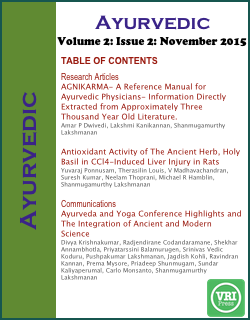 About Ayurvedic
About Ayurvedic
Ayurvedic (AV) is an international scientific journal, which is an open access and peer-reviewed journal that considers scientific based research articles, short communications, mini reviews and reviews in all aspects of Indian traditional medicine. Avurveda is one of the world’s oldest medical systems, which was originated in India more than 3000 years ago and remains active and one of the countries traditional health care systems. Ayurvedic journal is a part of Vedic Research International (VRI) journal system considers all aspects of traditional medicine along with laboratory and clinical studies using Ayurvedic medicines, its uses, treatment, applications results will be published in in “Ayurvedic†journal and we encourage all scientific community, herbalist, Ayurveda doctors, practitioners, laboratory and clinical scientists to join and submit their research articles, short communications, mini and full reviews, which will be critically reviewed by fellow scientists in their fields of expertise and important finding articles to get expedite publication in Ayurvedic journal.
Ayurvedic journal publishes quarterly (4 issues per year) with rapid peer reviewed system, which allows faster reviewing and publication.
Latest Issue Online
Volume 2, Issue 2Â is now available.
A Special Invitation for Sponsorship
Ayurvedic (AV) seeks organizations interested in supporting unbiased research and educational practices. Learn more about opportunities to align your organization with this important initiative.
Sponsors
Association of Ayurvedic Professionals of North America World Institute for Scientific Exploration, SKY and Amrityoga Sponsors of Ayurvedic (AV) will help advance topics and debates that address the most critical issue associated with continuing education in the healthcare field. A relationship with Ayurvedic (AV) positions sponsoring organizations as champions of unbiased research and educational practice among this discerning audience. Please contact admin, with any inquiries regarding sponsorship opportunities at vri@vripress.com |
VRI Press is become a member of CrossCheck, which check plagiarism (powered by iThenticate) in articles and books. VRI Press, Commited to provide high quality and original research papers.Â


VRI Press "2nd Book" Accepted and Will be released Very soon on VRI Press Book Store.

VRI Press "First Book" Released on July 4th, 2014 at Boone, NC in Sri Sri Ravi Shankar Ji Ashramam (Art of Living).
Sri Sri Ravi Shankar Ji released our first book titled "Unravelling Ayurvedic Mystery" authored "Dr. Shanmugamurthy Lakshmanan, PhD"
"This book will be available soon in Printed Copy" and also in Soft copy as PDF, iPhone/lPad and Android. If you  want to order one, send us email at "vri@vripress.com
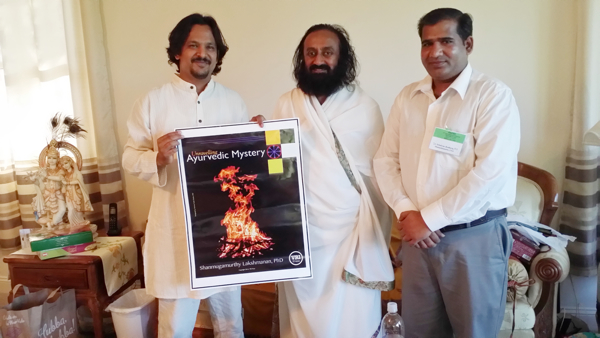

Â
Journal List
- Molecular Neuroscience
- Nano Therapeutics
- Onco Reviews
- VRI Phytomedicine
- VRI Cell Signaling
- VRI Biological Medicinal Chemistry
- VRI Bioinformatics & Proteomics
- Translational Clinical Biology
- Biomaterials Research
- Diabetic Reviews
- Hematological Reviews
- TME Reviews
- Pharmaco Reviews
- Biomarker Reviews
- Ayurvedic
- Immune Cell
- Gastro Reviews
- Ancient Science







Author Guidelines
Overview of manuscript submission process
Here are the brief outlines of the manuscript submission process for VRI Press journals.
- Prepare a cover letter briefly describing the significance of the work.
- Prepare manuscript text in Microsoft Word.
- Acceptable figure formats are TIFF, high quality JPEGs, EPS files.
- The figures should be sent to us as single PDF or PPT file.
- Supplemental data files (which includes text and figures) should be submitted as separate single word or PDF file.
- Upload the main manuscript file, supplemental data files and the cover letter                                                                Â
- All the manuscript must be formatted according to the VRI Press journal guidelines.
- If your manuscript is accepted for publication in VRI Press journals, you will be receiving an email to follow instructions to submit final edited and page-proof versions
- All authors on the manuscript or research article are responsible for the scientific content and obtain consent before publishing.
Preparing your Manuscript (Mini Review or Review)
We encourage all authors to submit manuscripts which are not previously published and not under consideration for publication elsewhere. Letters, Mini Reviews and Reviews and Manuscripts must be written in English, Authors from non-English speaking countries can take help from the certified professional editors within their campus/institution/university to avoid grammatical errors and typos before submitting the manuscript.
Â
Copyright and consent from co-authors
All authors must agree and approve the submission of the final version of the manuscript. After acceptance of manuscript, Corresponding author(s) must sign the copyright to the VRI Press journals.
Â
VRI Press journal article types
VRI Press review journals publish Letters, mini reviews and reviews. Reports,
Authors need to describe the significance of work in their summary/abstract. Introduction, methods, results and discussion sections should be precise. We encourage authors to avoid speculations and focus on their scientific data to describe in results and conclusions sections.Â
Publication charges
Author Fee: 75 USD per article (which includes color figures)
Schematics, Color Figures and Tables: Free of charge.
Criteria for the preparation color figures: We encourage authors to use color figures where they will enhance the presentation of the data. Any figure submitted in color will be reviewed and processed with the understanding that the figure will be published in color.
If you want to withdraw manuscript after reviewed, there will be 25 USD withdraw fee for each manuscript.
Reprints: A high quality copy of the final original published manuscript will be sent to corresponding author via email.
Manuscript Page Specifications
Authors should use 8.5 / 11-inch paper size, the text should be typed in double space throughout. The text should be submitted as single column format with 1 inch space on left and right column and 0.5 inches spacing between columns, from title, summary/abstract, introduction, methods, results, figure legends and discussion. All pages in the manuscripts and figures should be numbered appropriately (Typical Research Article should be below specifications).Â
Mini Reviews and Reviews
Must have Title, authors, affiliation, abstract, key words, Introduction and so on. Mini Reviews must be Less than 3500 words and full review must be more than 3500 words without references.
Manuscript Title
The title of the manuscript should be short and intelligible to the readers and should convey your essential meaning of the data presented in the manuscript. Which should not exceed 100 characters.
Authors
Authors should provide their complete names, affiliations and also specify corresponding author/s on the manuscript such as author’s name, phone and fax numbers, and current e-mail address.
Abstract
Authors should describe the significance of the findings reported in the manuscript clearly and concisely in the summary or abstract. Abstracts can have one or two references relevant to a scientific question. The summary or abstract should not exceed 250 words.
Keywords
You must mention at least five keywords and not more than eight key words
Introduction
The purpose of introduction should be extensive review of the literature and authors should include the purpose of the study, specifying the relationship of the literature to the relevance of the questions addressed in the manuscript.
Meaningful information with heard lines and so on.
References
Citations can include, books/chapters, reviews, reports, opinions and letters published in any scientific journals. These should be numbered, and journals were abbreviated as published with legibly written with details like title, volume, page number and year.
Follow the journal citation style of “Current Opinion in Immunology†if you use any type of reference managers like “Endnoteâ€
Important:Â Inside text must be use numbers as "[1]" and so on.
Reference Examples:
1. Koduru S, Wong E, Strowig T, Sundaram R, Zhang L, Strout MP, Flavell RA, Schatz DG, Dhodapkar KM, Dhodapkar MV: Dendritic cell-mediated activation-induced cytidine deaminase (AID)-dependent induction of genomic instability in human myeloma. Blood2012, 119:2302-2309.
Book Chapter:
2. Billoski TV: Introduction to Paleontology edn 6th. New York: Institutional Press; 1992.
3. Schwartz MT, Billoski TV: Greenhouse hypothesis: effect on dinosaur extinction. In Extinction. Edited by Jones BT, Lovecraft NV: Barnes and Ellis; 1990:175-189.
Conference Proceedings:
4. Magott J, Skudlarski K: Combining Generalized Stochastic Petri Nets and PERT Networks For The Performance Evaluation Of Concurrent Processes. Proceedings of the 3rd International Workshop on Petri Nets and Performance Models, December 11-13, IEEE Xplore Press, Japan, 1989:Â pp: 249-256.
Website Citation:
5. UNEP: Cleaner Production Assessment in Industries. Production and Consumption Branch. United Nations Environment Program, 2012. http://www.unepie.org/pc/cp/understanding_cp/cp_industries.htm (Accessed on February 13, 2011).
Abbreviations
Authors must define biochemical abbreviations in parenthesis first used in the text. Common biochemical abbreviations such as AChE, GAPDH, ADP, ATP, NAD, NADH, RNA, DNA need not be defined. Any such abbreviation/s which is/are not common, authors has to mention clearly when they are first used in the manuscript.
Figures
We suggest authors to make figures in RGB color mode, with high resolution using minimum of 300 dpi (dots per inch). If the figure contains multiple panels, they need to be annotated as Figure 1A, B, C, D, E and so on. Assemble single figure as one montage. Figure dimensions need to be specific with minimum of 6 X 6 inches. Any modifications such as brightness/contrast, or gamma corrections (with not less or more than 1) should be applied to the whole figure to get a uniform appearance.
Tables and Graphs
The line graphs and tables should be made with appropriate size, with the unit measurements must be mentioned near x or y-axes. The line should be 2 px thick and all letters should be minimum of 6 point size. Authors can use colors while making graphs and shade to express the % of expression in graphs and tables.
Data and Movie slides
We encourage authors to upload movies of appropriate files of protein 3D maps of protein / or biochemical data structures, microarray and NGS, RNA-seq data in movies or 3D slides in avi, ppt, tiff and docx files.
Supplementary files
Additional data will be reviewed thoroughly and considered as a part of the original manuscript as supporting information. The supplemental data should be submitted with the original manuscript with the following information: manuscript title, names of the authors with correspondence information which might include text, data, graphs, tables, figure legends and references and should be as a single PDF file.Â












